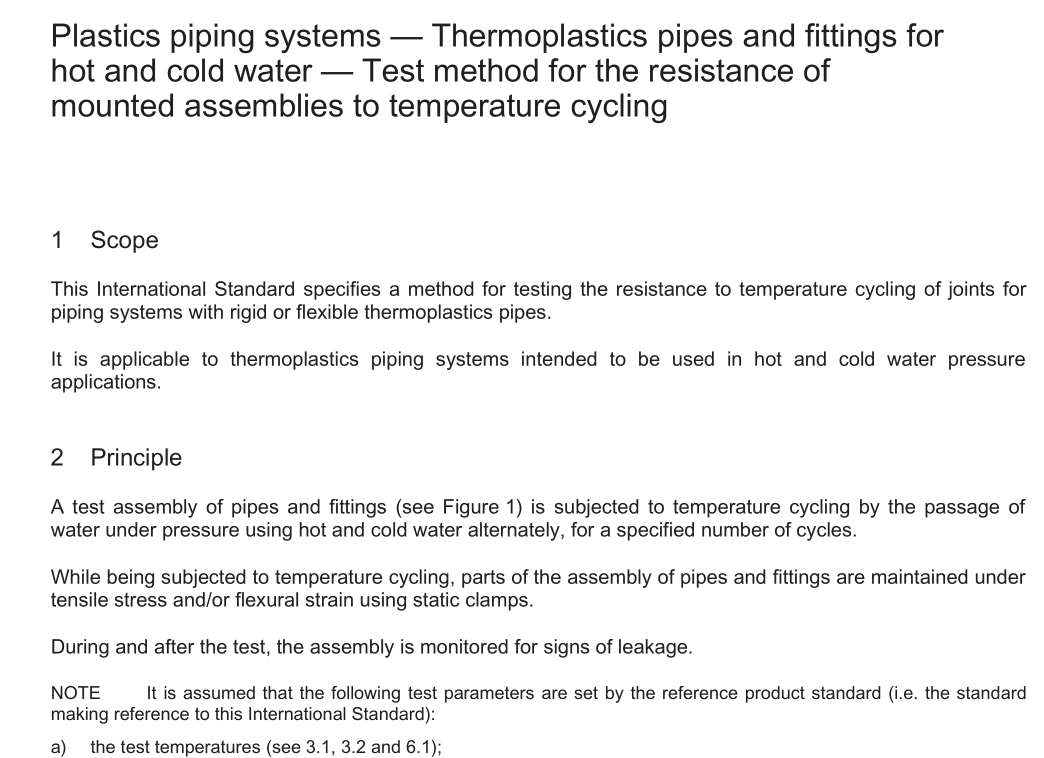BS ISO 19893 pdf download

BS ISO 19893 pdf download Plastics piping systems — Thermoplastics pipes and fittings for hot and cold water — Test method for the resistance of mounted assemblies to temperature cycling
1 Scope
This International Standard specifies a method for testing the resistance to temperature cycling of joints for piping systems with rigid or flexible thermoplastics pipes.
It is applicable to thermoplastics piping systems intended to be used in hot and cold water pressure applications.
2 Principle
A test assembly of pipes and fittings (see Figure 1) is subjected to temperature cycling by the passage of water under pressure using hot and cold water alternately, for a specified number of cycles.
While being subjected to temperature cycling, parts of the assembly of pipes and fittings are maintained under tensile stress and/or flexural strain using static clamps.
During and after the test, the assembly is monitored for signs of leakage.
NOTE It is assumed that the following test parameters are set by the reference product standard (i.e. the standard making reference to this International Standard):
a) the test temperatures (see 3.1, 3.2 and 6.1);
b) the duration of a complete cycle and each part of the cycle (see 3.1, 3.2 and 6.1);
c) the test pressure (see 3.6 and 6.1);
d) the tensile stress (see 3.8 and 5.3);
e) the bending radius (see Clause 4 and Figures 1 and 2);
f) the total number of cycles, including the first five cycles (see 6.2 and 6.3).
3 Apparatus
3.1 Cold water source, capable of all of the following:
a) supplying the water volume necessary to maintain the temperature variation throughout the test piece within the specified maximum difference (see 6.2);
b) supplying this water at the lowest temperature specified in the reference product standard with an accuracy of 2°C;
c) supplying this water for the duration of at least each cycle as specified in the reference product standard. If not specified otherwise in the reference product standard, to an accuracy of the duration time of 1 minute(s).
3.2 Hot water source, capable of all of the following:
a) supplying the water volume necessary to achieve the required water velocity (see 6.2);
b) supplying this water at the highest temperature specified in the reference product standard to an accuracy of 2°C;
3.3 Balancing valves, capable of regulating the water velocity as necessary to maintain the temperature variation throughout the test piece within the specified maximum difference (see 6.2). 3.4 Alternation equipment, capable of achieving each change in hot and cold water temperatures at the inlet within 1 min.
3.5 Thermometer(s), capable of checking conformity to the specified test temperatures (see 3.1, 3.2 and 6.2).
3.6 Pressure gauge(s) and a device, for regulating the water pressure in the test assembly at the pressure specified in the reference product standard to an accuracy of 0,5 bar 1 ) ( 0,05 MPa), except for brief pressure spikes, which can occur if the temperature of water is changed.
3.7 Supporting brackets, as appropriate, comprising anchor brackets (fixed points) capable of restraining piping components and guide brackets, capable of supporting piping components without inhibiting longitudinal movement (see Clause 5 and Figure 1).









